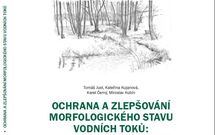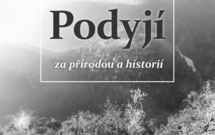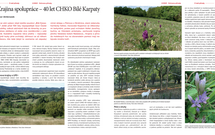The Journal is published by the Nature Conservation Agency of the Czech Republic in cooperation with the Cave Administration of the Czech Republic, the Krkonoše Mts. National Park Administration, the Bohemian Forest Mts. National Park Administration, the Podyjí National Park Administration and the The Bohemian Switzerland National Park Administration. It has been published since 1946.
cs / en
Nature Conservation 4/2008 — 19. 8. 2008 — Research, Surveys and Data Management
Bat of the Chýnov Cave – A Model Example of Survey and Protection of a Valuable Site
modelový příklad výzkumu a ochrany cenné locality

Největší krasový útvar jižních Čech – Chýnovská jeskyně v Pacově hoře poblíž Dolních Hořic na Táborsku – představuje nejen výjimečný geologický výtvor, ale i lokalitu významnou z hlediska chiropterologického (od Chiroptera – letouni), neboť slouží jako významné refugium netopýrů.
Systematic bat monitoring has been carried out in the Chýnov Cave in the Tábor region (southern Bohemia) since 1981/1982, at present in collaboration with the Chýnov Cave Administration. In 1981–2008, 64 checks of the wintering site (hibernaculum) and 103 trappings were performed there: of the latter, 18 were carried out in the winter period. In total, 4,770 bats were found, of them approx. 1,500 were trapped in nets. 10 bat species were found during the whole study period: they include the Greater House-eared Bat (Myotis myotis), Daubenton's Bat (M. daubentonii), Natterer's Bat (M. nattereri) and Brown Long-eared Bat (Plecotus auritus), also known as the Common Long-eared Bat. The Bechstein's Bat (M. bechsteinii), Whiskered Bat (M. mystacinus), Serotine Bat (Eptesicus serotinus) and Barbastelle Bat (Barbastella barbastellus) occur irregularly. The Brandt's Bat (M. brandtii) and Geoffroy's Bat (M. emarginatus) visit the Chýnov Cave only exceptionally. The bat community (synusium) composition changes in the particular seasons. At the Chýnov Cave, the Natterer's Bat numbers continually culminates and in the bat hibernation peak phase (January to February) the species is up to two fifths of the whole bat community number. Dominancy of two species, namely the Brown Long-eared Bat and Daubenton's Bat is clear for the first sight (together 63.5 % of all the bats trapped). Nevertheless, they amount to only 22.5 % in the dominancy during the winter period: both the species are replaced by the Natterer's Bat and Greater House-eared Bat (70.2 %). Since 2004, bat numbers has been increasing in the Chýnov Cave: in ten years, they increased approx. two to three times. The increase has been due to the Naterrer's Bat and particularly to the Greater House-eared Bat. The process has been caused by a lot of drivers. In addition that it is in line with the general increase in bat numbers at long-term monitored wintering sites in other parts of the Czech Republic, the process has been no doubt stimulated by the suitable conservation management at the site.
Název připojené galerie
Quisque egestas velit non nulla fermentum, aliquet pharetra nunc malesuada. Nullam molestie vel diam non tincidunt. Sed pulvinar lacinia nunc et consectetur. Duis varius leo ac ex scelerisque, ullamcorper eleifend massa consectetur. Nullam in metus ac arcu pellentesque venenatis ac id lorem. Nulla nec ipsum sed enim sodales blandit a sit amet ex.

Foto M. Anděra

Foto M. Anděra

Foto M. Anděra

Foto M. Anděra

Foto M. Anděra

